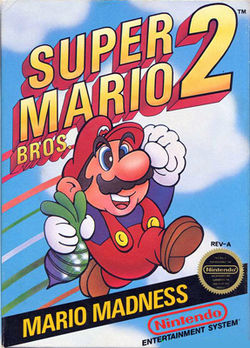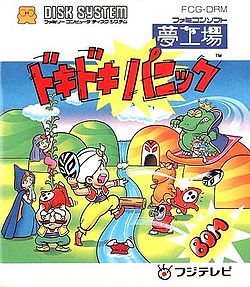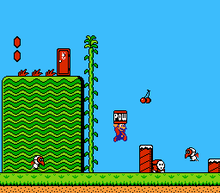- Super Mario Bros. 2
-
This article is about the version released outside of Japan. For the Japanese game with the same name, see Super Mario Bros.: The Lost Levels.
Super Mario Bros. 2 
North American box art, with Mario holding a vegetableDeveloper(s) Nintendo EAD Publisher(s) Nintendo Director(s) Kensuke Tanabe[1] Composer(s) Koji Kondo[2] Series Mario Platform(s) Nintendo Entertainment System, Super Nintendo Entertainment System, Game Boy Advance, Virtual Console Release date(s) Genre(s) Platforming Mode(s) Single-player Rating(s) Super Mario Bros. 2, often abbreviated SMB2, is a platform game developed and published by Nintendo for the Nintendo Entertainment System as a sequel to the 1985 game Super Mario Bros. The game was also remade as part of the Super Mario All-Stars collection for the Super Nintendo Entertainment System (SNES), released on August 1, 1993 in North America and December 16, 1993 in Europe. It was rereleased on the Wii's Virtual Console in Europe, Australia and New Zealand on May 25, 2007 and the U.S. on July 2, 2007.
Unlike the majority of other Mario titles, Super Mario Bros. 2 was not developed from the ground up. Rather, it is a redesign of the Japanese Family Computer Disk System game Yume Kōjō: Doki Doki Panic (夢工場ドキドキパニック Yume Kōjō: Doki Doki Panikku, "Dream Factory: Heart-Pounding Panic"). Nintendo's original sequel to Super Mario Bros. was released in Japan as Super Mario Bros. 2 in 1986; however, because of that game's difficulty and its close similarities to the original game, Nintendo decided not to release it in the West at that time. Because Super Mario Bros. 2 is a redesign of a non-Mario game, the game differs greatly from the original Super Mario Bros., though many elements from the game have since become part of the Mario series canon. The redesigned Western version of Super Mario Bros. 2 was released in Japan in 1992 under the title Super Mario USA (スーパーマリオUSA Sūpā Mario USA), and in 1993 a 16-bit remake of the original Japanese version was released to the rest of the world as Super Mario Bros.: The Lost Levels as part of Super Mario All-Stars.
Contents
Gameplay
Super Mario Bros. 2 is set in the dream-land known as Subcon. Mario's task is to free Subcon from Wart, the game's final boss.
The game is a side-scrolling platform game. At the beginning of each stage, the player is given a choice of four protagonists to control: Mario, Luigi, Toad, and Princess Peach. Each character has different strengths; Mario is a well-rounded character; Luigi can jump the highest of the four; Toad can run and pluck vegetables the fastest but can't jump well; and Peach can jump the farthest, due to her ability to hover for a short time, though she is the slowest runner and slowest at plucking items from the ground. All characters have the ability to increase the height of their jump by ducking briefly before they jump.
Unlike the previous and following Mario games, no enemies can be defeated by jumping on them. Instead, the player character must throw objects at enemies, such as vegetables plucked from the ground. Certain opponents can be picked up and thrown as well, and several levels feature blocks marked with the word "POW", which when picked up and thrown kill all the enemies on screen at impact, similar to the one in Mario Bros.
The game features a life meter, a then-unusual feature in the series. The player begins each stage with two points of health, represented by red hexagons (in remakes, they are shaped like hearts), and can increase the number of health points in the meter by collecting mushrooms. Health can be replenished by floating hearts, which appear after a certain number of opponents have been defeated. The invincibility star from the previous game appears, with a player needing to collect five pairs of cherries to acquire it.
Each stage contains one or more hidden flasks of potion. When plucked and thrown, a potion creates a door to Sub-Space, an alternate world in which coins are collected instead of vegetables when plucked. The mushrooms used to increase the health meter can also be found here. The player automatically leaves Sub-Space after a short time. The coins collected are used in a slot machine mini-game played between stages. This mini-game is the chief means of obtaining additional lives. In addition to the mushrooms and slot machine coins, several Sub-Spaces are also used as warp zones; these involve the use of vases as pipes.[3]
Development
Yume Kōjō: Doki Doki Panic 
Developer(s) Nintendo EAD Publisher(s) Nintendo
Fuji Television NetworkDirector(s) Kensuke Tanabe[4] Producer(s) Shigeru Miyamoto Composer(s) Koji Kondo Platform(s) Family Computer Disk System Release date(s) - JP July 10, 1987
Mode(s) Single-player The original Japanese version of Super Mario Bros. 2 is known in North America, Europe and Australia as Super Mario Bros.: The Lost Levels. Visually, it looked like Super Mario Bros., with the same basic game format but with a completely different level design that delivers a higher difficulty setting.[3] Nintendo of America disliked the Japanese Super Mario Bros. 2, which they found to be frustratingly difficult and otherwise little more than a modification of Super Mario Bros.. As they did not want to risk the franchise's popularity, they canceled its stateside release and eventually decided on reworking Yume Kōjō: Doki Doki Panic into the Western Super Mario Bros. 2.[3]
Yume Kōjō: Doki Doki Panic (夢工場 ドキドキパニック) is a platforming game that follows a family of four, each with different abilities, on a quest to rescue kidnapped kids in a fantasy world. The title was a license cooperation between Nintendo and Fuji Television to promote the broadcaster's Yume Kōjō '87 event, which showcased several of their latest TV shows and other products at the time. The game features the mascots of the Yume Kōjō festival – a family consisting of siblings Imajin and Lina and their parents, Papa and Mama – as protagonists. The rest of the characters, including the main villain, Mamu, are creations by Nintendo for the game. Yume Kōjō: Doki Doki Panic takes place within a book with an Arabian setting. All four characters are playable, and the game is not fully completed until the player clears all levels with each protagonist. In Super Mario Bros. 2, Mario, Luigi, Peach, and Toad were built on Imajin, Mama, Lina, and Papa's models, respectively, marking the first time that Mario and Luigi had noticeably different heights.[3] Some elements from the Mario universe already existed in Yume Kōjō: Doki Doki Panic, such as Starmen, coin and jumping sound effects, the POW blocks and level warping. Additionally, the game's soundtrack was composed by Koji Kondo,[5] the original Super Mario Bros. composer, and needed only a few alterations and new compositions throughout the conversion.[2] Both Yume Kōjō: Doki Doki Panic and Super Mario Bros. 2 were directed by Kensuke Tanabe.[1][4]
Doki Doki Panic originally started as a Mario game prototype developed by Kensuke Tanabe. The prototype emphasized vertically scrolling levels and throwing blocks. Notably, it was originally intended to be a two player co-op game allowing players to toss each other around. The gameplay was considered not fun enough at the time and was scrapped until later when Tanabe received instruction to use the Yume Kojo mascots in a game, at which point he expanded the gameplay and developed Doki Doki Panic.[6]
Re-releases
In 1993,[7] Nintendo released an enhanced SNES compilation titled Super Mario All-Stars. It included all of the Super Mario Bros. games released for the Nintendo Entertainment System and Famicom. The version of Super Mario Bros. 2 included in the compilation had improved graphics and sound to match the SNES's 16-bit capabilities, as well as minor alterations in some collision mechanics. Among other enhancements, it was also possible to change the character after losing a single life, while the original version allowed to change it only after completing a level or when the player lost all its lives and chose "Continue", making the game much more forgiving when choosing a character not adept at some specific level. Also, the player began with 5 lives instead of 3, and the slot game gained an additional character: if he could get three "7", the player could win ten lives.
In March–April 1996, Nintendo (in collaboration with the St.GIGA satellite radio station) released an ura- or gaiden-version of the game for the Satellaview system featuring graphical enhancements similar to Super Mario All-Stars. This new game was entitled BS Super Mario USA Power Challenge (BSスーパーマリオUSA パワーチャレンジ), and like all Satellaview titles it was released episodically in a number of weekly volumes.[8] BS Super Mario USA Power Challenge was never released outside of Japan and as with all other Satellaview titles it has never been re-released as a stand-alone title. The game exists today solely in ROM-format and is traded online by Satellaview emulation enthusiasts.[8]
Super Mario Advance
In 2001, Super Mario Bros. 2 received another release (this time based on the All-Stars remake) as part of Super Mario Advance (which also contained a remake of Mario Bros.). Super Mario Advance was developed by Nintendo Entertainment Analysis and Development,[9] and was a launch title for the Game Boy Advance. The Super Mario Advance version of Super Mario Bros. 2 includes several new features such as the addition of the enemy Robirdo (a robotic Birdo acting as the boss of World 3, replacing Mouser), the addition of the Yoshi Challenge (in which players may revisit stages to search for Yoshi Eggs), and an all-new point-scoring system (a first for the game). Graphical and audio enhancements were also added in the form of enlarged sprites, multiple hit combos, digital voice acting, and such minor stylistic and aesthetic changes as an altered default health-meter level, boss-order, backgrounds, the size of hearts, Princess Toadstool being renamed to the now-standard "Princess Peach," and the inclusion of a chime to announce Stars.[10]
Reception
Super Mario Bros. 2 sold ten million copies, and was the third highest-selling game ever released on the Nintendo Entertainment System at that time.[11] Nintendo Power listed Super Mario Bros. 2 as the eighth best Nintendo Entertainment System video game, mentioning that in spite of not being originally a Mario game, it was able to stand on its own merits and its unique takes on the series' trademark format.[12] Super Mario Bros. 2 was ranked 108th out of 200 of the "Greatest Games of Their Time" by Electronic Gaming Monthly.
When it was re-released in 2001 as Super Mario Advance it received generally positive reviews, garnering an aggregate score of 84% on Metacritic.[13] One reviewer concluded "all nostalgia and historical influence aside, Super Mario Bros. 2 is still a game worth playing on the merits of its gameplay alone", also saying that "the only reason you may not want to pick it up is if ... you already own it in another form."[14] However, GameSpot thought that Super Mario Bros. 3 or Super Mario World would have been a better choice for a launch game considering their respective popularity;[15] both titles were eventually also remade as part of the Super Mario Advance series. Conversely, IGN praised the choice, calling it "one of the most polished and creative platformers of the era".[10] The game was named one of the NES best games ever by IGN, saying that the game offers greater diversity in graphics and gameplay than the original, making it a great bridge game between the other NES Mario titles.[16] The game was ranked as the ninth worst game in the Mario game series by ScrewAttack; they said that while it was a good game, it felt like a lie because they weren't playing the real Super Mario Bros. 2.[17] They also named the music played in the battle against the final boss Wart in the eight best 8-Bit Boss Themes.[18]
Legacy
Many elements in Super Mario Bros. 2 stayed for the game's sequels and related games in the series. The game added the ability to pick up and toss enemies and objects, a move that has become part of Mario's permanent repertoire, appearing in other Mario games including Super Mario Bros. 3, Super Mario World, Super Mario 64, Super Paper Mario, Super Mario Sunshine, New Super Mario Bros., New Super Mario Bros. Wii, Super Mario Galaxy and Super Mario Galaxy 2.[14][19][20][21] Other elements of Super Mario Bros. 2 have been assimilated into the greater Mario universe as well -– Birdo, Pokey, and Shy Guys are notable examples.[14] This is the first game in which Princess Peach and Toad are featured as playable characters. Princess Peach herself has gone on to star in other Mario games such as Super Princess Peach[14] while Toad has received supporting roles in later Mario games and has starred in games like Wario's Woods and New Super Mario Bros. Wii. This is also the first game where Luigi received the appearance he has today (notably, he is taller than Mario).[3][14] In the Super Smash Bros. series, Peach not only has the ability to pluck and throw vegetables, she can also float in mid-air both in the same vein as this game. The Subspace element from Super Mario Bros. 2 made a reoccurring appearance in the "Scott Pilgrim" series which, like the game, is accessed through magic doors.
References
- ^ a b "Interview - Kensuke Tanabe Talks Metroid Prime 2: Echoes". Nintendo World Report. 18 May 2004. Archived from the original on 11 September 2010. http://www.webcitation.org/5sfp8s6Ll. Retrieved 11 September 2010.
- ^ a b (2005) Album notes for Nintendo Sound Selection vol.3 Luigi: B-Side Music. Scitron Digital Contents Inc..
- ^ a b c d e McLaughlin, Rus. "IGN Presents The History of Super Mario Bros.". http://retro.ign.com/articles/833/833615p2.html. Retrieved 2009-04-13.
- ^ a b "クリエイターズファイル 第101回". Gpara.com. 10 February 2003. http://www.gpara.com/contents/creator/bn_101.htm. Retrieved 11 January 2011.
- ^ Nintendo Entertainment Analysis and Development. Yume Kōjō: Doki Doki Panic. (Nintendo Co., Ltd.). Scene: staff credits. (10 July 1987)
- ^ "The Secret History of Super Mario Bros. 2". wired.com. 3 April 2011. http://arstechnica.com/gaming/news/2011/04/the-secret-history-of-super-mario-bros-2.ars. Retrieved 3 April 2011.
- ^ "SNES: Super Mario All-Stars". GameSpot. http://www.gamespot.com/snes/action/supermariocollection/index.html?tag=result;title;0. Retrieved 2008-08-27.
- ^ a b Kameb (12 February 2008). "スーパーファミコンアワー番組表" (in Japanese). The Satellaview History Museum. http://www.f3.dion.ne.jp/~kameb/satella/st_prg/st_prg.htm. Retrieved 29 March 2009.
- ^ "Joining Nintendo After Super Mario". Iwata Asks: Super Mario Bros. 25th Anniversary. Nintendo of America, Inc.. 13 September 2010. http://us.wii.com/iwata_asks/mario25th/vol3_page1.jsp. Retrieved 19 January 2011.
- ^ a b "Super Mario Bros. 2: Super Mario Advance - Game Boy Advance Review at IGN". IGN. http://gameboy.ign.com/articles/165/165853p1.html. Retrieved 2010-02-26.
- ^ "All Time Top 20 Best Selling Games". 2003-05-21. Archived from the original on 2006-02-21. http://web.archive.org/web/20060221044930/http://www.ownt.com/qtakes/2003/gamestats/gamestats.shtm. Retrieved 2006-12-01.
- ^ NP Top 200. 231. Nintendo Power. August 2008. pp. 71..
- ^ "Super Mario Advance (gba) reviews at". Metacritic.com. 11 June 2001. http://www.metacritic.com/games/platforms/gba/supermarioadvance?q=super%20mario%20bros%202. Retrieved 20 July 2009.
- ^ a b c d e "Super Mario Bros. 2 Review". IGN. IGN Entertainment, Inc.. 5 July 2007. http://wii.ign.com/articles/801/801793p1.html. Retrieved 25 August 2009.
- ^ "Super Mario Advance for the Game Boy Advance review". GameSpot. http://www.gamespot.com/gba/action/supermarioadvance/review.html. Retrieved 2010-02-26.
- ^ "18. Super Mario Bros. 2". IGN. 11 June 2001. http://www.ign.com/top-100-nes-games/18.html. Retrieved 10 April 2010.
- ^ "ScrewAttack - Top Ten Worst Mario Games". ScrewAttack. http://www.gametrailers.com/video/top-ten-screwattack/23547. Retrieved 2010-04-11.
- ^ "ScrewAttack - Top Ten 8-Bit Boss Themes". ScrewAttack. http://www.gametrailers.com/video/top-10-screwattack/64349. Retrieved 2010-04-11.
- ^ "Mario's Basic Moves". Nintendo Power: Strategy Guide (Nintendo) SG1 (13): 4. 1990.
- ^ "Full Coverage — Super Mario 64". Nintendo Power (Nintendo) (88): 14–23. September 1996.
- ^ Miller, Skyler. "Super Mario World - Review". Allgame. http://www.allgame.com/game.php?id=2630&tab=review. Retrieved 2009-07-13.
External links
- Super Mario Bros. 2 guide at StrategyWiki
- TGWTG video feature on the story behind Super Mario 2 and Doki Doki Panic
- Yume Kojo: Doki Doki Panic - Super Mario Wiki, the Mario encyclopedia
- BS Super Mario US
- Super Mario Bros. 2 Madness - From Doki Doki Panic to SMB2
- Yume Kōjō: Doki Doki Panic - The strange truth behind Super Mario Bros. 2
- Super Mario Bros. 2 at NinDB
- Official Super Mario Advance site
- The Secret History of Super Mario Bros. 2 at Wired.
Categories:- 1988 video games
- Game Boy Advance games
- Mario platform games
- Mario Universe games
- Nintendo Entertainment Analysis and Development games
- Nintendo Entertainment System games
- PlayChoice-10 games
- Satellaview games
- Video game remakes
- Virtual Console games
- Video game sequels
Wikimedia Foundation. 2010.

